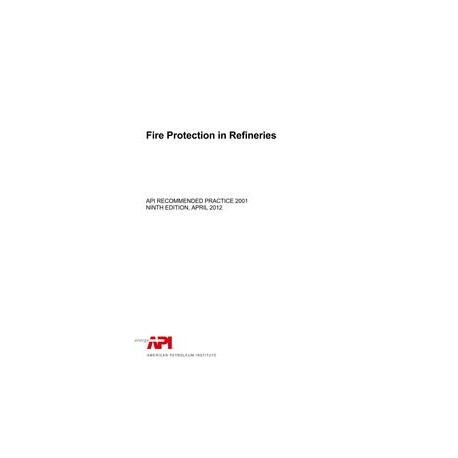Cart
0
Product
Products
(empty)
No products
To be determined
Shipping
$0.00
Total
Product successfully added to your shopping cart
Quantity
Total
There are 0 items in your cart.
There is 1 item in your cart.
Total products
Total shipping
To be determined
Total
New
Reduced price!
 View larger
View larger
 View larger
View larger
API RP 2001
M00022938
New product
API RP 2001 Fire Protection in Refineries, Ninth Edition
standard by American Petroleum Institute, 04/01/2012
In stock
More info
Full Description
The purpose of this recommended practice is to provide a better understanding of refinery fire protection and the steps needed to promote the safe storage, handling, and processing of petroleum and petroleum products in refineries. A basic premise of this standard is that fire prevention provides the fundamental foundation for fire protection.This document covers basic concepts of refinery fire prevention and protection. It reviews the chemistry and physics of refinery fires; discusses how the design of refinery systems and infrastructure impact the probability and consequences of potential fires; describes fire control and extinguishing systems typically used in refineries; examines fire protection concepts that should be covered in operating and maintenance practices and procedures; and provides information on organization of and training for refinery emergency responders. Many of the concepts, systems, and equipment discussed in this document are covered in detail in referenced publications, standards, or governmental requirements.
Hazards are situations or properties of materials with the inherent ability to cause harm. Flammability, toxicity, corrosivity, and stored electrical, chemical, or mechanical energy all are hazards associated with various industrial materials or situations.
Risk requires exposure. A hot surface or material can cause thermal skin burns or a corrosive acid can cause chemical skin burns, but these can occur only if there is contact exposure to skin.
A person working at an elevated height has "stored energy" and a fall from a height can cause injury, but there is no risk unless a person is indeed working at heights and thus exposed to the hazard. There is no risk when there is no potential for exposure.
Determining the level of risk for any activity involves understanding and recognizing hazards, then estimating the probability and severity of exposure events that could lead to harm or damage, and the resulting consequences. Principles relating hazards to the risk for people are valid for evaluating property or environmental risk. For instance, hydrocarbon vapors in a flammable mixture with air can ignite if exposed to a source of ignition resulting in a fire that could cause property damage as well as injure people. Hydrocarbons that will burn are hazardous materials, but one element of risk includes a flammable fuel-air mixture being exposed to an ignition source.

